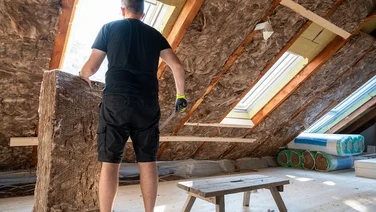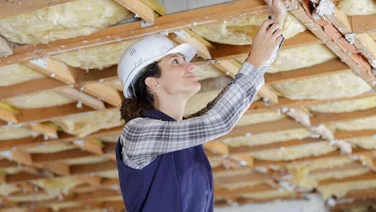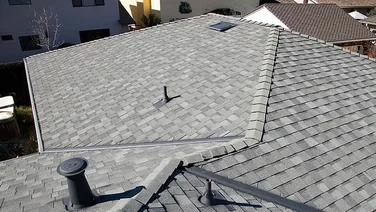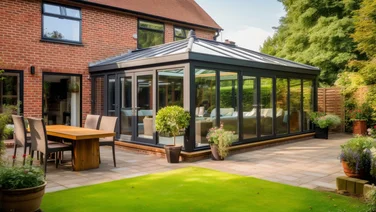- Roof insulation costs, on average, between £400 and £600
- Roof insulation can save you between £200-£380 on your energy bills each year
- The cost you’ll pay for insulation depends on the material you use
- You may qualify for the Great British Insulation Scheme
Roof insulation costs, on average, between £400 and £600, but this can increase depending on the type of roof insulation you get. Installation costs can add an additional £150 to £250 per day per tradesperson, though, with the average installation being one or two days. This will vary depending on the company you use.
But roof insulation can save you up to £340 on your energy bills each year, according to the latest figures from the Energy Saving Trust.
In this guide, we dive deeper into roof insulation costs, including labour and materials costs, as well as how to reduce the cost of roof insulation and how much it would cost to remove or replace your current roof insulation.
If you’re already clued up on pricing and are ready to get some quotes, fill out our form and our trusted suppliers will be in touch.

How much does roof insulation cost in the UK in 2024?
As we’ve already mentioned, roof insulation costs between £400 and £600, depending on the type of insulation you choose to install.
We’ll go into more detail below, but as an overview, here’s the different types of insulation you can install:
- Warm deck insulation:
- Spray foam insulation
- Fibreglass insulation
- Mineral wool rolls
Average roof insulation costs
The cost you’ll pay for insulation depends on the material you use and the house you have. The table below shows the average roof insulation costs for different materials.
| Type of insulation | Area covered | Costs |
|---|---|---|
| Fibreglass insulation | 20m² | £380-£420 |
| Mineral wool rolls | 20m² | £300-£480 |
| Spray insulation | 20m² | £700-£900 |
| Warm deck insulation boards | 20m² | £600-£700 |
Roof insulation cost per m²
If you have less than or more than 20m² of area to cover, use the table below to get a more detailed idea on what you might pay.
| Type of insulation | Costs per m² |
|---|---|
| Fibreglass insulation | £5-£7 |
| Mineral wool rolls | £6-£10 |
| Spray insulation | £21-£31 |
| Warm deck insulation boards | £16-£21 |
Similar to the above, the aforementioned costs are an estimate and we recommend getting a range of quotes, which you can get by filling in our form.
Labour costs
The labour costs you pay will depend on the work you’re having done. The average loft insulation cost in the UK is between £200-£250 per day.
A conservatory roof insulation, however, will cost drastically more. The labour and insulation costs will be between £2,600-£3,000 and takes one-to-three days.
A flat roof insulation and a warm roof insulation costs around £600-£800. A spray roof insulation will be in the region of £700-£900 per 20m².
Surveys and inspections
Before you begin your installation, you’ll need an initial survey conducted of your home. This will also be the case if you plan to apply for the Great British Insulation Scheme.
In terms of what happens during the survey, a professional will inspect your property and discuss your plans for roof insulation and then explain the full process.
From here, you’ll then decide on appropriate methods and which materials you’d like to use.
As noted by MyBuilder, you’ll be a good candidate for cavity wall roof insulation specifically if:
- Your home was built between 1924 and 1982
- Your wall cavities are at least two inches wide
- Your brickwork or masonry is in good condition
- Your walls are dry, with no signs of damp on the interior or exterior
- Your ventilation is adequate or there’s potential to fit a vent successfully
- Your external walls are accessible to installers
How to reduce roof insulation costs
You can reduce roof insulation costs by utilising and applying for a government grant.
The Great British Insulation Scheme is directly related to roof insulation that allows you to get free or cheaper insulation to reduce your home’s energy bills, but there are strict criteria around the grant.
You might get support if your home:
- Has an Energy Performance Certificate of D to G
- Is in Council tax bands A-D in England or A-E in Scotland or Wales
The good news is that you can be a homeowner, landlord or tenant, either privately or from a housing association. If you are renting, speak to your landlord before you apply, as you’ll need their permission before anything can be installed.
The Scheme allows you to get support to install:
- Cavity wall insulation
- Solid wall insulation
- Loft insulation
- Flat or pitched roof insulation
- Underfloor insulation
- Solid floor insulation
- Park home insulation
- Room-in-roof insulation
To determine whether you qualify for the Scheme, you’ll need to know your total household income, the types of benefits anyone living in the property receives, your email address or phone number so your energy supplier can contact you if you’re eligible.
From here, your energy supplier will arrange an assessment of the property and any costs involved will be discussed with you afterwards. You can decide not to use the services if you disagree with the assessment or costs.
There are other grants available, but these are specific to roof insulation.
These include:
- ECO4 – Run by energy suppliers and can cover the cost of installing energy efficiency improvements
- Warm Homes Scotland – Can cover up to 100% of the costs or offer a zero-interest loan if eligible
- Nest (Wales) – Can cover up to 100% of the costs towards measures like loft or wall insulations
- Home Upgrade Grant (now ended)- Previously offered up to 60% of the costs of installation and ran until March 2025
- Warm Homes: Local Grant – Offers £15,000 per property for improvements like insulation and glazing. An additional £15,000 is available for low-carbon heating, such as heat pumps.
Each grant or scheme focuses on low-income and vulnerable households, who would benefit the most from this financial support.
You can find more information on these grants in more detail by checking out our full guide to UK government grants for ‘free’ insulation.

How much does it cost to remove or replace roof insulation?
If you already have roof insulation, there are some scenarios where it might need replacing.
Look for the following signs, as noted by My Builder:
- If your have unusually high energy bills, it could suggest poor insulation
- If you have uneven temperatures throughout your home are also signs of poor insulation
- If your insulation is old, there’s a chance it might not meet current energy efficiency standards, so might benefit from an upgrade
If any of these apply, it might be worth investing in new roof insulation.
In terms of cost, a three-bedroom home, you can expect it to cost around £3,200. For every m², the average cost is around £40.
This figure, according to CheckATrade, is assuming that it takes two-to-three tradespeople a week to complete, at £175 each day.
“It also includes £100 for specialist disposable, given the toxic nature of some kinds of spray foam,” its website states. “You will also need to factor in the cost of skips.”
The price you pay will be dependent on your location, the access to the attic or loft, the size of your loft and the thickness of the insulation.
It’s worth noting that removing some types of roof insulation, such as roof foam, will be significantly higher than others.
“With most insulation types, you’re looking at closer to £300 for safe removal and disposal, as it will generally just roll up or pull away,” the CheckATrade website claims.
Summary
- There are several options for roof insulation, meaning it’s not a one size fits all and really comes down to researching suppliers, getting tailored quotes from them and making the right choice for you
- Prior to speaking with potential suppliers, make a list of questions you want to find out from them, such as installation timings, the full process, what happens if there are delays, etc
- Also make a list of what’s important to you with your supplier. This could be anything from communication to offering competitive pricings
- You can reduce roof insulation costs by utilising and applying for a government grant
- We can help with getting tailored quotes from our list of trusted suppliers. All you need to do is fill in this form with a few details and we’ll do the rest. When our suppliers receive your information, they’ll be in touch directly.







